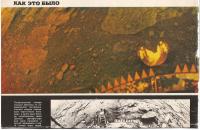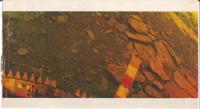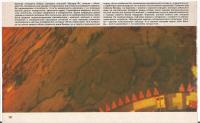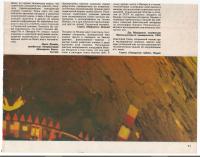Printable Version of Topic
Click here to view this topic in its original format
Unmanned Spaceflight.com _ Venus _ Venus surface images
Posted by: ngunn Mar 9 2021, 09:47 AM
I have a question arising from the recent surface images acquired by the Parker Solar Probe (but best discussed in this section, I think, if anyone has comments). Would a camera with similar specifications to WISPR but located on Earth or in Earth orbit be able in principle to image the night-side surface? It presents quite a large target when suitably placed and I imagine some sort of coronagraph arrangement could be used to exclude light from the sunlit crescent.
EDIT - link reposted here: https://www.nasa.gov/feature/goddard/2021/parker-solar-probe-offers-a-stunning-view-of-venus
Posted by: JRehling Mar 9 2021, 06:45 PM
The simple answer is, yes, it can be done from Earth, and is, but there is one big problem from Earth that you can avoid in space: The glare of the thin crescent of Venus's dayside. Venus's dayside is just so, so much brighter than the nightside signal that any image suffers from the intrusion of that glare if it exists. Even from space, the dayside glare is a threat to any such image.
This was done first by an amateur, Christophe Pellier. The pros have done some better renditions of it in the meantime.
https://skyandtelescope.org/astronomy-news/amateur-images-venuss-surface/
I'm also proud to say that in 2020 I have succeeded in capturing the limb of Venus in this way, but I got at best a hint of surface detail. The constraints from Earth are extraordinary because:
1) It must be done when Venus is a thin crescent.
2) It has to be done when the sky is dark.
corollary: Venus must be low in the sky, causing atmospheric interference to be maximized.
3) Infrared's long wavelengths mean that diffraction limitation of resolution for any given aperture is worse than at visible wavelengths.
4) Because Venus's rotation is quasi-synced to the orbital relationship with Earth, we only see part of Venus – the same part at each opportunity. Maybe 40% of Venus is visible and the rest won't be for a very long time.
These constraints all affect the pros as well as the amateurs. No matter how nice your gear is, every one of those things is still true.
Still, even if it's not that useful for science, I find it exciting that it's even possible and that I was able to image the surface of Venus, however rudimentary the result.
Posted by: JRehling Mar 9 2021, 07:14 PM
Another important thing to say here: The signal that is imaged here is thermal, obviously, since there is no reflection going on. It therefore is an image of altimetry – temperature varies with altitude on Venus and not for any other reason. This has some noise introduced into it because the atmosphere itself radiates IR just as the surface does, but the surface is much denser and emits much more thermal IR.
So, the one and only thing that is being observed here is altimetry, which is already very well known.
Obviously, if we saw something surprising, like a volcanic eruption, that would be novel. We could in principle use this to track fluctuations in Venus's rotation, but there are limits on the resolution, and that is done better with radar.
There might be some clever ways to eke surface science out of this, like measuring specific heat?
Posted by: rlorenz Mar 10 2021, 03:09 AM
Eliot Young has obtained some very good results with the IRTF telescope (spectral image cubes, in fact, which I dare say is rather labor-intensive to process) Not sure if there is anything published on it yet tho
And there are even a few credible amateur examples. I think it would be a very good project for a university observatory with a telescope in the 14-30 inch class. A Lyot mask or similar to exclude the dayside crescent would help a lot. IIRC when Hansell and Hunten used the Arizona 61-inch to search for lightning with a (for the time) fast CCD, they had a custom mask made for each day of observation, since the geometry was slightly different
Posted by: ngunn Mar 10 2021, 11:58 AM
Thanks John and Ralph for filling in the picture on terrestrial observations. I would note that observing from above Earth's atmoshere would at least overcome constraint no.2. On the question of what might be seen at thermal wavelengths other than altimetry I suppose there is the possibility of transient dust-raising events caused by weather, landslips, seismic activity or whatever.
Posted by: scalbers Mar 10 2021, 07:48 PM
If measurements were accurate enough the surface emissivity could be studied.
Posted by: JRehling Mar 11 2021, 04:35 PM
It took me a while to find these but a couple of amateurs (really straining the definition of the word) have posted their nightside images of Venus here.
These were taken from Australia with a 20" telescope (amateur!) by Phil Miles with occasional collaboration mentioned in his posts by one or more others.
http://www.astrogem.com.au/Venus/nightside-2020/
It's wildly impressive but still falls short of what can be done from space, of course. And even an Earth-orbiting satellite is hamstrung by the rotational synchrony: You can only image certain portions of Venus well (about 20%-25% of it) when it's a waning crescent, and another 20-25% when it's a waxing crescent, and such observations are only possible for about 1 month out of every 19.
From the Earth's surface, such observations are limited by the scant minutes per day. There are only about 20-30 minutes per day to image the thin crescent and gathering all the light you can with all the IR you can capture fills that 20-30 minutes pretty well. Amateurs are typically imaging with a filter that blocks out everything shorter than about 1 micron (900 nm might work). On the longer end of wavelengths, the filter might allow no real limit but the camera itself, as well as the atmosphere of Venus dim out the signal so you're probably effectively imaging off about a 100nm wide band. Trying to get a multispectral signal for a fancy emissivity study by slicing up your spectrum would probably eliminate the signal to noise. And, as I mentioned, the long IR wavelengths mean a much harsher diffraction limit on your resolution, even if your scope is in space.
Of course, either Veritas or EnVision would be making such observations from Venus orbit and I think that's a dataset much to be desired. Until we make such observations, it is still speculative what science can be had because there's a need to compensate for [Venus] atmospheric interference with the surface signal and the richness of the surface signal itself depends upon the mineralogy of Venus, which is out of our hands, and the thing that we'd like to investigate. But the preliminary work done with Venus Express data is convincing that this dataset is worthwhile… yet to be seen is how worthwhile.
This is part of why I've been crossing my fingers throughout the last two Discovery selections for Venus to get its first U.S. mission since Magellan.
Posted by: rlorenz Mar 12 2021, 03:13 AM
Or DAVINCI+, whose carrier/relay spacecraft now goes into orbit with a 1-micron imager after the probe mission
https://www.hou.usra.edu/meetings/lpsc2020/pdf/2599.pdf
(
Posted by: JRehling Mar 12 2021, 07:57 PM
Indeed! It speaks loudly that a global map of the surface "colors" in IR is part of the plan for all these proposed missions.
Posted by: Marcin600 Mar 15 2021, 10:05 PM
Here are my scans of photos taken by the Venera 13 and 14 probes, which were published in a color Russian newspaper around the mid-1980s.
I don't remember the title of the newspaper or the exact year it was published - I only have 2 pages torn out of it. But I'm pretty sure they were published sometime before 1986. The newspaper was issued on chalky paper and contained photos - for a Soviet edition - of very good quality.
I have no idea how these photos were processed for publication. Seems like a little too much red hue has been given (?), but in general the photos contain a lot of details and are devoid of "artifacts of modern computer processing" (this was the era before PCs). The downside is, however, mechanical abrasions and minor damage to the paper (they are quite old).
I do not know if they bring anything new, but they give a slightly different impression than the well-known modern computer reconstructions of Venera 13 and 14 photos, and ... I have always liked them ![]()
Posted by: JohnVV Mar 15 2021, 10:58 PM
this is the set i have seen most
https://airandspace.si.edu/sites/default/files/styles/slideshow_lg/public/images/WEB12184-2011_640.jpg?itok=SbWzRgFX
and what i based my huge Venus surface map( 24 Gig ) color on
just found this
every image from the surface
https://www.planetary.org/articles/every-picture-from-venus-surface-ever
Posted by: Hungry4info Mar 17 2021, 10:49 PM
There's significantly more images from the surface of Venus than just the ones contained there; the cameras on Venera 13 and 14 took several images each (even if from the same perspective). Maybe they were different colour filters, but there is some separation in time between the images, and the recent conversation about Venus' images encouraged me to see about putting some together into a sort of animation. In this case, I've taken the images from the Venera 13 Camera 1 and "animated" them after some (extraordinarily) crude alignment. I think I can see dust clearing off of the landing ring near the bottom-centre of the image. Edit: I've done the same with the images I have from Venera 13 Camera 2 and the dust motion is far, far more conclusively visible.
Posted by: Hungry4info Mar 17 2021, 11:35 PM
And here's the same from Venera 14 Camera 1, taking the three usable frames for this. It looks like there was a dramatic removal of dust between two of the frames that also perturbed the... debris thing(?) near the centre of the frame. There is only one usable frame from the Venera 14 Camera 2, so I will not attempt it on the other side. It doesn't look like any dust was kicked up anyway, being the famous "smooth slab" image.
Has this been noticed before? I did some googl'ing around and found https://www.researchgate.net/publication/23849803_Landing_induced_dust_clouds_on_Venus_and_Mars and http://adsabs.harvard.edu/full/1990EM%26P...50..127G which talk about dust kicked up by the landers, but I didn't read anything on visual confirmation of dust being moved by wind.
Posted by: rlorenz Mar 18 2021, 01:53 AM
Has this been noticed before? I did some googl'ing .....I didn't read anything on visual confirmation of dust being moved by wind.
Of course it was noticed. But it is indeed perhaps not well known, and is quite remarkable, you would typically have to wait weeks or months to see such a change on Earth
As my review of Venus surface wind measurements notes "The probabilistic framework articulated in this paper supports
this contention of vigorous surface transport. Surface panoramas (e.g. Garvin et al., 1984) from the Venera landers show fine material
to be widely present. Of the 6 landers equipped with cameras, four returned images (the lens caps on Venera 11, 12 failed to
eject). Of these, only Venera 13 and 14 provided multiple panoramas which allowed change detection. Changes in the distribution
of surface particulates on the lander ring are seen in Venera 13 images (e.g. Selivanov et al., 1982; see also discussion in
Ksanfomality et al., 1983). Thus, out of only two occasions in which surface particle transport could possibly have been observed, it was
observed in one (with only about an hour between observations). Movement of surface particulates by wind has been observed on
many occasions on Mars, indeed (e.g. Lorenz and Zimbelman, 2014), but only after years of landed spacecraft operations (e.g.
Arvidson et al., 1983; Sullivan et al., 2005) and high-resolution orbital observations (e.g. Bridges et al., 2012).
The paper by the original imaging investigator is
Selivanov, A.S. et al., 1982. Evolution of the Venera 13 imagery. Sov. Astron. Lett. 8, 433–436.
Posted by: Marcin600 Mar 19 2021, 07:33 PM
Outstanding, Hungry4info!
This is the first time I can see any movement on the surface of Venus!
Really amazing - after so many years you can still discover something new in such old photos.
The gusts of wind had to be strong enough to blow away the dust/sand that was lying on the lander's aerodynamic ring (sand/dust that fell on the ring when the probe landed).
PS Do you have the option to use slightly larger pictures for these animations?
And what exactly is this "debris thing(?) near the centre of the frame" ? Damaged camera cover?
Posted by: Hungry4info Mar 20 2021, 01:17 AM
I'm afraid not. Those are the highest-resolution images I have. I'm definitely interested in knowing if anyone else has larger raws though.
Posted by: alex_k Jul 27 2023, 02:48 PM
Not only dust but also small stones are moving.
Posted by: Phil Stooke Jul 27 2023, 06:16 PM
A reminder that the Venera images can be found here:
http://mentallandscape.com/C_CatalogVenus.htm
- as well as a lot of useful information about the camera operations.
Phil
Powered by Invision Power Board (http://www.invisionboard.com)
© Invision Power Services (http://www.invisionpower.com)








